Growing brussels sprouts in the home garden is easier than you might think. In this post, I’ll show you all you need to know in order to get the biggest and best yields.

The unique appearance of brussels sprout plants might make a beginner nervous to try them in their garden.
They do require a fairly long season and ideal conditions in order to produce a large bounty of edible heads. But growing brussels sprouts is a lot of fun when you know how to care for them.
Below I’ve shared all the information you need in order to be successful.
You will learn about watering, sun, fertilizer, soil, pest control, and much more so you’ll know how to grow brussels sprouts that are healthy and highly productive.
Brussels Sprouts Quick Care Overview
| Scientific name: | Brassica oleracea var. gemmifera |
| Classification: | Vegetable |
| Common names: | Brussels sprouts |
| Hardiness: | Biennial zones 2+ |
| Temperature: | 45-75°F |
| Flowers: | Yellow, blooms second year spring-summer |
| Light: | Full sun |
| Water: | Keep evenly moist, do not overwater |
| Humidity: | Average |
| Fertilizer: | High nitrogen fertilizer spring-summer |
| Soil: | Rich, fertile, well-draining |
| Common pests: | Aphids, cutworms, slugs, snails, flea beetles, cabbage worms, loopers |
Information About Brussels Sprouts
Brussels sprouts are cole crops, or cruciferous vegetables, from the Brassicaceae family. They are related to cauliflower, broccoli, kohlrabi, and the full-size cabbages the tiny heads resemble so much.
They’re cool weather veggies that have a long growing season, and will continue producing even after frost.
The tall stalks can reach a surprising 3-4’ tall and are covered in wide green leaves. Most varieties will start producing sometime between 90-130 days.
Different Types Of Brussels Sprouts
There are more than a dozen brussels sprout varieties that have different characteristics. Some may be more or less ideal for your growing zone or tastes. Here are just a few to give you an idea.
- Jade Cross – This high yield variety grows more compactly and tolerates higher temps.
- Red Bull – These brussels sprouts sport a red hue and milder flavor.
- Churchill – This early maturing type has a shorter growing season and tolerates most climates.
- Falstaff – The reddish-purple heads and leaves with a sweeter flavor are a fun variety to try.
- Red Rubine – This heirloom variety has a gorgeous shade of purple, which is beautiful in the garden and on your plate.

Hardiness
Many new gardeners are surprised to learn that brussels sprouts can survive the winter and grow again the next year, even in cold climates down to zone 2.
But they are biennials, so the second year they will bolt (flower) and produce seeds rather than forming edible heads.
Though you certainly could save the seeds for replanting, most gardeners pull them out to make room for new plants each year.
How Do Brussels Sprouts Grow?
The tiny heads form all along the central stem of brussels sprouts plants, where you’ll find each one just above the junction of a leaf.
The taller it gets, the more leaves and heads it will form. The ones at the bottom will mature and be ready to eat first, which means you can usually enjoy them for several weeks.

How To Grow Brussels Sprouts
Choosing the right garden location with plenty of growing space is the best way to give your brussels sprouts a good start. Let’s talk about how to find the perfect spot.
Where To Grow Brussels Sprouts
The height and size of brussels sprouts plants makes them ideal for growing in the ground or in raised beds. They need a lot of space, so they aren’t a good choice for containers.
Choose an area that gets full sun, has rich, fertile well-draining soil, and plenty of room. Each plant will need at least 2’ between them in order to flourish.
When To Plant Brussels Sprouts
Exactly when to plant brussels sprouts depends on your climate. They need a very long season in order to produce mature heads, and don’t do well in extreme heat.
In areas with hot summers, plant them in the fall or early winter to protect them from the heat.
For cold climates, start them indoors several weeks before your last spring frost date so they have plenty of time to mature before winter.
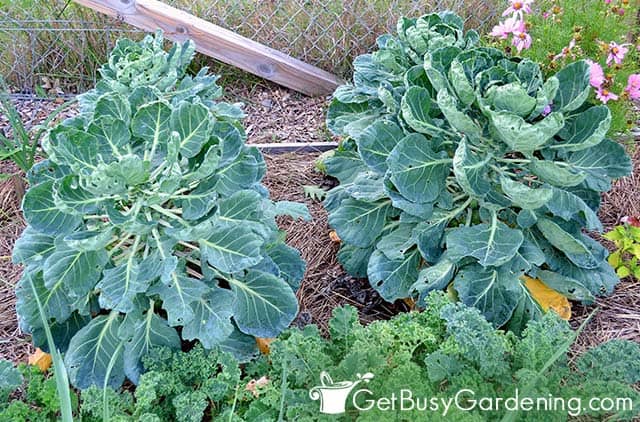
Brussels Sprouts Plant Care & Growing Instructions
Once you understand what conditions brussels sprouts prefer, growing them isn’t difficult. Here are all the details about the ideal conditions to keep them thriving.
Sunlight
Despite not loving heat, brussels sprouts do love the sun. In cool climates, providing them with 6+ hours of direct sunlight a day is ideal.
If you experience high temperatures, choose a partial shade location that protects them during the hottest part of the day. Too much heat can prevent heads from forming.
Water
The best tasting and well formed brussels sprouts will grow on plants that receive consistent, even watering. They like to get about 1 ½ inches per week from rain or irrigation.
They have shallow roots that can dry out very quickly. So keep the soil evenly moist at all times, but don’t water to the point of making it soggy.
During heat waves you’ll need to keep a closer eye on them. An inexpensive moisture meter can be a great tool to make sure they get the perfect amount.
Temperature
Brussels sprouts are very cold hardy, and grow best in cooler weather. They’ll thrive in temperature ranges of 45-75°F.
But they can survive down to 20°F in the winter, especially when given some protection during hard freezes.
Heat can make the stalks bolt instead of forming edible heads. So it’s important to plant them at the right time of year, and mulch around the base to help keep the soil cool.
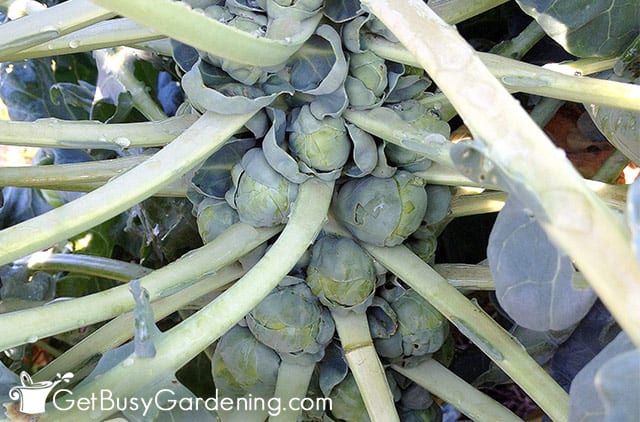
Fertilizer
Brussels sprouts are heavy feeders. So in order to encourage the largest most flavorful heads, keep them well fed using a nitrogen rich blend.
Start during planting time by mixing compost, aged manure, and/or slow-release granules into the hole.
As the season goes on, continue to top dress them with granules monthly, or use a liquid compost tea weekly.
Soil
They thrive with consistent moisture, but hate wet feet. So your brussels sprouts will grow best in a well-draining, fertile soil with a pH between 6-6.8.
I recommend amending heavy, sandy, or poor quality soils with compost to improve fertility and drainage.
Test the pH using a probe before planting brussels sprouts. If needed you can add garden lime to reduce the acidity if it’s too high.
Pruning
Pruning throughout the season is a great way to refocus the plant’s energy on brussels sprout formation, rather than growing larger leaves.
As the stalk gets taller, the lower leaves will naturally begin to yellow. You should trim those away with sharp sterilized pruners so the plant no longer expends energy on them.
Toward the end of the season, when you know a hard freeze is nearing, you can remove all of the top leaves from the stalk. That will direct the energy to maturing all the heads left on the plant.
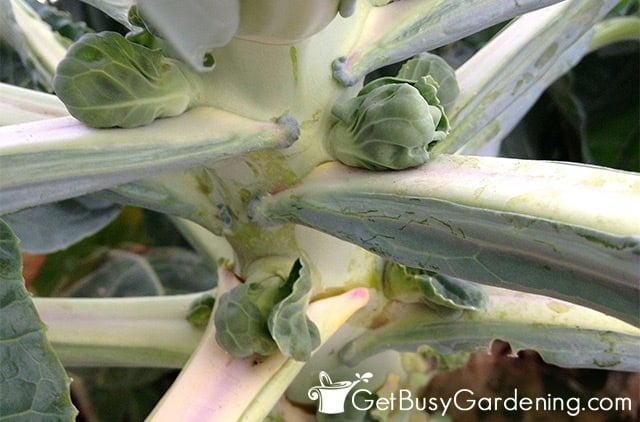
Pest Control Tips
Unfortunately, we aren’t the only ones who want to nibble on fresh brussels sprouts. Bugs like aphids, cutworms, slugs, snails, flea beetles, and cabbage worms and loopers love to feast on all parts of the plant.
Managing them begins with row covers to protect young starts. Keeping weeds away and cultivating the soil gently can also deter pests.
Hang yellow sticky traps nearby to capture jumping and flying insects. Organic insecticidal soap can be useful, as can hand picking large bugs. Spray small insects off with a sharp stream of water from the hose.
Disease Control Tips
Different fungal diseases like Alternaria blight, powdery mildew, black rot, and clubroot can damage the leaves and affect head development.
One of the best ways to prevent problems is by managing the pests that can spread them.
A natural fungicide can help to slow the spread. It’s also a good idea to water near the roots instead of overhead to prevent soil from splashing up.
Rotate your crops too. Brassicas grown in the same location every year can harbor and help to spread soil borne diseases.
Tips For Harvesting
When it’s finally time to harvest I have good news, it’s easy! They can be eaten at any size, but 1-1.5” diameter heads are ideal.
If possible, I recommend waiting until after the first few frosts of the season, as the flavor improves each time.
To gather them, simply twist or cut the heads from the stalk. They will mature from the bottom up. So work from the base first, leaving the smaller ones near the top to keep growing.
That way you can enjoy them throughout the season. Learn more about exactly when and how to harvest brussels sprouts here.
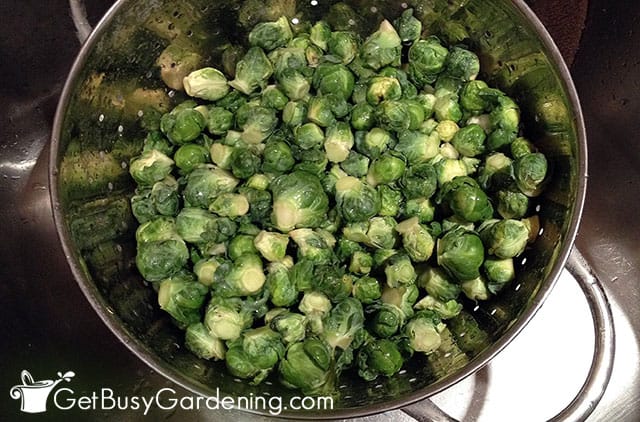
Troubleshooting Brussels Sprouts Growing Problems
Once you get the hang of it, growing brussels sprouts is pretty simple. But if you run into any problems, these tips can help you get them healthy again.
Holes In The Leaves
Holes in brussels sprouts leaves usually indicate a pest issue. Flea beetles make tiny holes, while cabbage loopers or worms will create irregular, larger ones.
Spread diatomaceous earth to keep beetles and other pests away. Hand pick off any large bugs you see, and lightly spade the soil to destroy any larvae.
Small Or No Heads
If the heads fail to form, or don’t seem to be getting any larger, they could be having an issue with heat, inconsistent water, or lack of nutrients.
Brussels sprouts are a cool weather crop and don’t grow well when it’s hot. Anything above 75°F can cause loose, small heads, or prevent them from developing.
They’ll also need evenly moist, nitrogen rich soil to develop well-formed ones, as well as regular fertilizer applications.
Plant Not Growing
If your brussels sprouts plant is simply not growing it could be caused by highly acidic soil or clubroot disease. Use a probe to test the pH and, if it’s below 6.0, add garden lime to help neutralize it.
Club root is unfortunately a soil borne disease that can live for years and stunt the roots. It’s important to rotate them every year to avoid this problem.
Heads Are Open Or Loose
If you notice loose brussels sprouts, it’s likely too hot for them. Heat will cause the heads to be open and loose rather than tightly closed and firm.
If the weather is cool enough, it could be that you’re waiting too long to harvest. Over time the heads will begin to open and turn yellow. Pick them as soon as they’re about 1” large to prevent that.
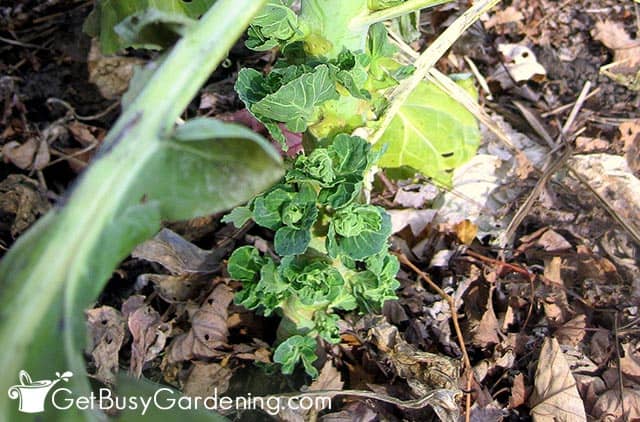
FAQs About Growing Brussels Sprouts
Below I’ve answered some of the most commonly asked questions about growing brussels sprouts. If yours isn’t on the list, please ask it in the comments section below.
Are brussels sprouts easy to grow?
Brussels sprouts are easy to grow once you understand the care and environment they require. Cool temperatures, plenty of sunlight, and consistent moisture will result in the best crop.
How long does it take to grow brussels sprouts?
How long it takes to grow brussels sprouts depends on the variety. Some early maturing ones can produce in as little as 85 days, while others take upwards of 130.
How many brussels sprouts do you get from one plant?
How many brussels sprouts you get from one plant really depends on the variety and the environment. In ideal conditions, a single plant can produce somewhere near 3 lbs of heads.
Do brussels sprouts come back every year?
No, brussels sprouts do not come back every year. They’re a biennial, which means they only live for two years. So while the plant can survive more than one year, in the second it’ll produce flowers and seeds, rather than edible heads.
How tall do brussels sprouts grow?
How tall brussels sprouts grow depends on the variety, but they can reach between 3-4’ with the proper care.
Now you have all the information needed to grow brussels sprouts in your garden. Even beginners can enjoy these unique vegetables with the care tips above.
If you want to learn how to grow vegetables vertically, then you need a copy of my book Vertical Vegetables. It will teach you all you need to know in order to have both a beautiful and bountiful veggie garden. Order your copy today!
Or you can learn more about my Vertical Vegetables book here.
More About Vegetable Gardening
Share your tips for how to grow brussels sprouts in the comments section below.
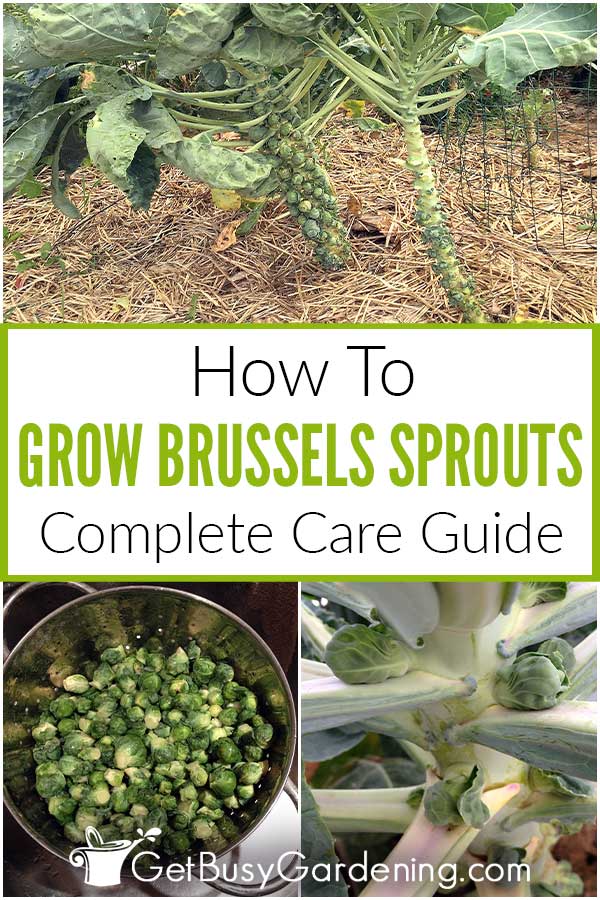
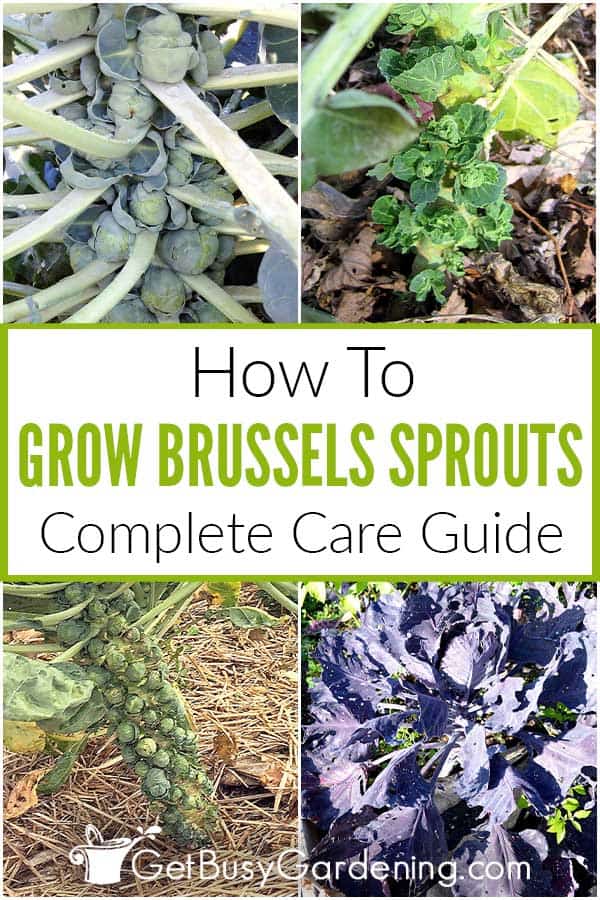
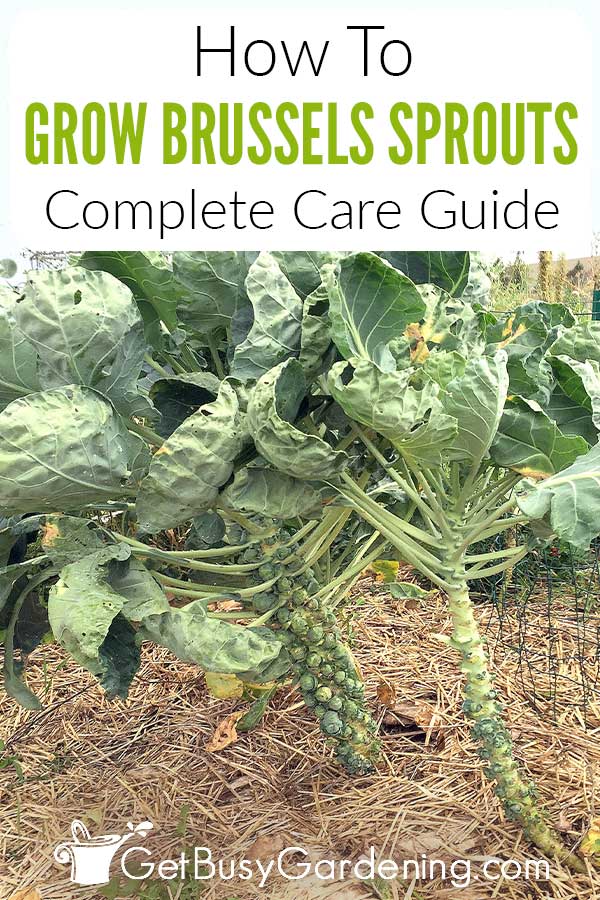



Leave a Reply